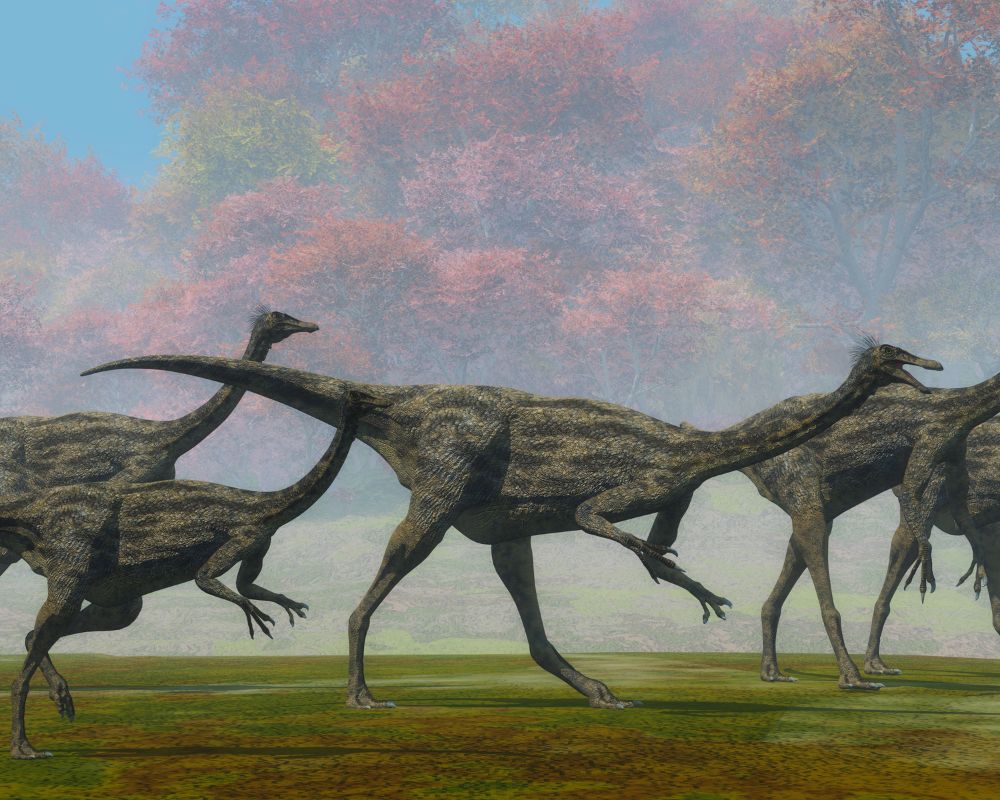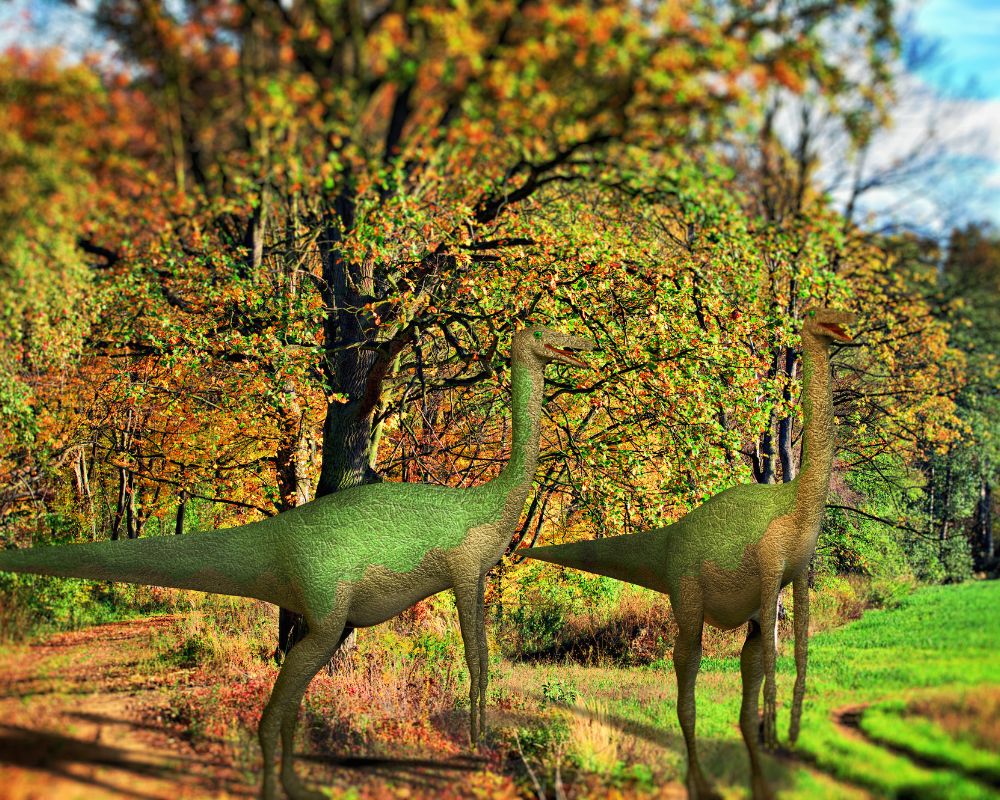A Gallimimus looked more like an ostrich than a dino. Long legs, a long neck, a small head, and feathers earned this Late Cretaceous period dino the name “Chicken mimic.” Its most dinosaur-like features were a long tail and skinny forelimbs with claws.
Table of Contents
Some Quick Facts About the Gallimimus

| Name | Gallimimus bullatus (meaning “Chicken mimic”) |
| Type of dinosaur | Ornithomimid Theropod dinosaur |
| Territory | Warm, swampy regions of Late Cretaceous Mongolia |
| Size | Small dino, 20 feet long, 6.5 feet tall, 900 pounds |
| Color | Gray or brown with contrasting stripes for camouflage and feathers |
| Interesting Characteristics | Long neck and large eyes like an ostrich |
| Diet | Probably an omnivore, possibly a herbivore |
| Major Threats | Carnivores like Tarbosaurus and Raptors |
The Gallimimus might be called the Chicken mimic, but this small Theropod dinosaur is considered the fastest. It is thought to have reached speeds of 40 mph or more. With long legs, long neck, and large eyes, the Gallimimus was similar to emus and ostriches.
How Big was the Gallimimus?

The Gallimimus was about the size of an ostrich. It also shared other adaptations with ostriches, including high speed. Galli could run about 40 mph or more!
This dino was the biggest of the Ornithomimidae family. Other dinos from the Clade Ornithomimosauria were bigger, like the huge Deinocheirus. Even though it was pretty big compared to other Ornithomimids, the Gallimimus was much smaller than massive Theropods like a Tyrannosaurus rex.
What did the Gallimimus Eat?
Paleontologists aren’t sure what the Gallimimus ate. The mouth was much like a duck’s mouth, meaning the Gallimimus could’ve been a filter feeder. The Gallimimus was either an herbivore or an omnivore.
Still, paleontologists are sure the Gallimimus ate plants. Whether they also ate, small animals is up for debate. Since almost all Theropod dinosaurs were carnivores, the Gallimimus could have been an omnivore that ate small animals, lizards, and insects.
Did Velociraptors Eat the Gallimimus?

The Gallimimus was the Velociraptor’s prey. This might surprise you because the Velociraptor was about the size of a turkey. That means the Gallimimus was bigger than the Velociraptor.
The Gallimimus was about the size of the version of the Velociraptor seen in Jurassic Park movies. That’s because the Velociraptor in Jurassic Park was modeled after a larger raptor called Deinonychus. Luckily the Gallimimus was much faster than the Velociraptor, so it was often able to escape Velociraptor’s sharp claws and teeth!
When and Where Did the Gallimimus Live?
The Gallimimus lived in the Maastrichtian era of the Late Cretaceous period. This was about 70-66 million years ago. The Gallimimus resurfaced in the Nemegt Formation of the Gobi Desert in the 1960s.
The name Gallimimus was given to this new species by paleontologists Rinchen Barsbold, E. Roniewicz, and H. Osmólska. “Mimus” means “Mimic,” and “Galli” means “Chicken” or “Rooster.” These paleontologists found several Gallimimus fossils in a bone bed, leading them to believe that this dino lived in family groups.
What Dinos Did the Gallimimus Live With?
The Gallimimus lived with its closest relative, Anserimimus, in Mongolia. It also lived in the same period as Tarbosaurus and Velociraptor. These dinos lived at the end of the Mesozoic era, going extinct when the asteroid hit the Earth.
Mongolia had some of the most interesting Late Cretaceous period dinos, including:
- Alioramus
- Borogovia
- Deinocheirus
- Mononykus
- Protoceratops
- Tarchia
- Therizinosaurus
What Dinosaurs Were Related to the Gallimimus?
The Gallimimus was related to Ornithomimosaurs like Deinocheirus and other Ornithomimids. The Gallimimus comes from Family Ornithomimidae, which includes Ornithomimus and Struthiomimus. The family name Ornithomimidae means “Bird mimics.”
This family of dinos had long necks and small heads. These dinos were part of the Coelurosaurian Theropod dinosaurs, which include modern birds. Other species of dinos from this group are:
- Compsognathus
- Maniraptora
- Tyrannosaurus
The Gallimimus was certainly an interesting-looking dino. Even though it couldn’t fly, the Gallimimus had feathers and many other bird-like features. It’s not hard to believe that the Gallimimus was an ancestor of modern birds since ostriches and emus look so much like this dino!

